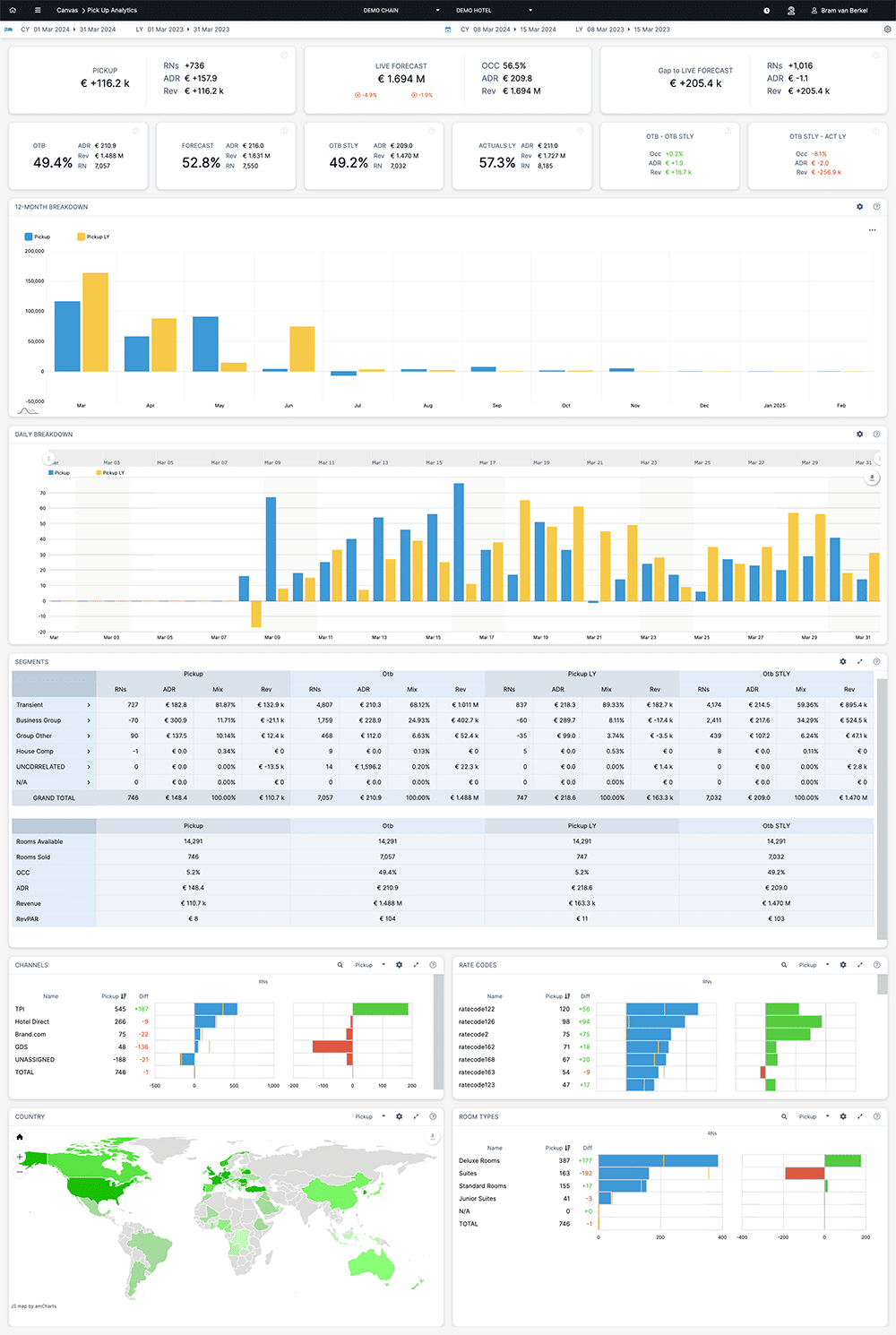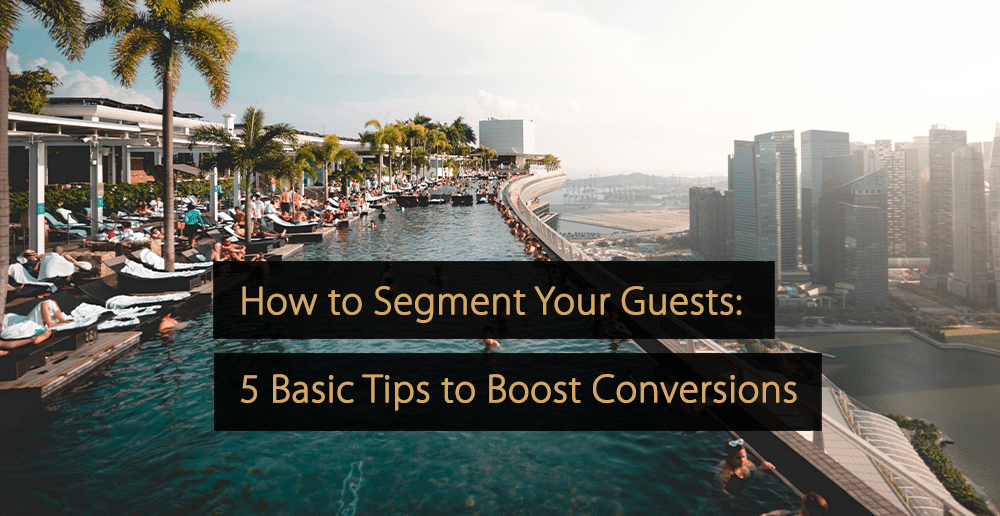Pick-up analytics are essential for hotels to forecast demand, optimize pricing strategies, manage inventory, marketing, and improve revenue management. In this article, we will dive into the world of Pick-up Analytics. You will learn what Pick-up Analytics is and how to use it to help your hotel optimize performance.
What is Pick-up Analytics?
In short, it is important to analyze the rate at which your hotel rooms are booked over a certain period.
Pick-up Analytics provide insight into booking trends, guest behavior, and future demand. It shows the number of rooms sold during a specific timeframe (“Pick-up window/period“). It compares it to the previous period(s) and your expectations regarding your Forecast and Budget.
By leveraging Pick-up Analytics, you learn how quickly your rooms are booked for a specific date or date range (“Stay window/period“), enabling you to adjust pricing, marketing activities, and operational strategies accordingly.
By contextualizing the data with information on past bookings, cancellations, competitor data, and more, you can assess whether your hotel is picking up business quickly to match expected future performance – and take action if not.
Why Should You Analyze Pick-up?
There are numerous benefits to keeping tabs on the Pick-up of Business in your hotel, to name a few:
- Forecast demand: By monitoring the pace at which bookings are coming into your hotel and the associated booking trends and patterns, you can forecast demand more accurately and identify busy and slow periods in your business.
- Pick-up Analytics also allows you to validate your expectations (forecast/budget) and ensure you are on track to achieve budgeted/forecast performance.
- Optimize revenue: By understanding how quickly your rooms are being sold, you can adjust rates to reflect demand. This could help increase your hotel’s average rate (ADR) and occupancy.
- Manage availability: To optimize profitability, manage your availability across channels to allow bookings with the highest net revenue contribution. Be sure to look at elements such as total net booking value (taking into account length of stay, ADR, channel commission, and average ancillary spend).
- Strategic planning and Marketing: Insights from Pick-up Analytics can guide your decisions on room allocations, promotions, advertising efforts, and operational staffing/planning to ensure they are targeted and best positioned for performance.
- Reporting: Other hotel stakeholders, including hotel owners/head office and operational leaders, will be keen to learn how the business will progress commercially in the future. Awareness will help with (financial) planning and alignment on future strategy.
- Competitive advantage: By staying on top of your property’s Pick-up and market developments, you will gain a competitive edge that allows you to act instantly on trends and benefit from opportunities. It will also prevent unnecessary downsides, such as a sudden drop in demand for specific dates.
How Should You Analyze Pick-Up?
Here is a structure to guide you in monitoring and analyzing Pick-up. Note that you may want to adjust the structure depending on your property’s commercial dynamics (including property type, location, market, etc.).
Building a Pick-up Analysis structure: Which things should you look at, and at what intervals? We recommend the following starting point, from which your analyses can evolve as you see fit:
A) Daily: Look at the next 30-45 days (depending on your property’s average booking window) and assess Pick-up over the last 1-day, 3-day, and 7-day windows. Look for outliers, specifically Pick-up by segment and channel, to identify opportunities to drive occupancy and profitability. Are there any patterns for specific stay dates? Compounding Pick-up?
How does Pickup relate to Pickup and Performance at the Same Time Last Year (STLY)? What are the Pickup drivers (i.e., events, corporate business, OTAs, and groups)?
- Relate the Pick-up to your hotel’s pricing and competition and explain how these elements vary from STLY.
- Check Pick-up by Month for the next year to quickly spot any anomalies, and dig deeper by applying filters or breakdowns if you have to.
- Are deviations/anomalies one-offs or part of a trend/pattern?
- Depending on the outcome, take action: adjust rates, open/close promotions, apply/remove restrictions, etc.
- Look at recently identified patterns and see if/how they continue to evolve.
B) Weekly: Analyze your Pick-up more strategically for the next 30-, 60- and 90-day stay windows, paying particular attention to more dynamic date ranges such as event- and holiday periods. To understand the movements, look at Pick-up for each future month by DOW, Segment, Country, and Channel. You may add dimensions relevant to your hotel, such as Room Type and Loyalty status. These movements will help identify where you are moving more than expected and less than expected.
Any changes shortly and significant changes further in the future that are likely to result in forecast adjustments should be communicated to other hotel stakeholders. Update your near-term forecast if significant deviations occur.
C) Monthly: Adjust your forecasts for the next 12 months using the outcomes from your Pick-up Analyses.
What Is the Outcome of Analyzing Pick-up?
Being aware of Pick-up across the various dimensions mentioned has many benefits. These include:
- Ability to mitigate risks as early as possible to minimize their impact
- Identifying and acting on opportunities to capture revenue/profit
- Understanding the underlying dynamics that are influencing your property’s future performance
- Action points for the broader hotel organization to act on. This includes staffing and purchasing planning to minimize costs and capitalize on peak business periods.
- Increase profitability from the sales of your limited inventory.
Regularly evaluating Pick-up will make your hotel more resilient against (potential) downturns and more dynamic to capture upside.
Key Considerations Related to Pick-up Analytics
In this section, you will discover key considerations related to pick-up analytics.
- Less analytically inclined team members in the hotel may not know how to translate the analytics into action; you may need to guide them.
- Before running an analysis, define your objective: define rate strategy. Implement promotions to support soft periods? Identify anomalies? Find ADR opportunities? Etc.
If you skip this step, you may fall into the trap of analysis paralysis and spend an inappropriate amount of time crunching numbers without a specific outcome. - Pick-up can be more defining and appropriate to analyze than analyzing your total business on the Books (BOB). BOB “has already happened,” and Pick-up shows movement. Therefore, Pick-up is a better and more current measure of future activity/trends, allowing you to impact that future by taking action.
- Getting insights from raw booking data or PMS extracts is a tedious activity that takes a lot of time, especially when extracting, cleaning, and structuring data before any insights can be obtained. This process must be repeated whenever you want to run your analytics with refreshed data. If you will embed Pick-up Analytics structurally in your decision-making, consider a Business Intelligence tool like Juyo Analytics that automates the data processes and lets you focus your time on where it can be of most value. The ROI is instant.
What Would a Starting Point for a Pick-up Analytics Dashboard Look Like?
The Pick-up Analytics Constellation is defined as follows and, when used as a starting point for your journey, helps you analyze Pick-up as described above with minimal clicks:
- Overall KPIs of the Business (BOB, Forecast, RMS Forecast, STLY – and variances).
- Pick-up will be by a future month for the Pick-up window selected.
- Daily Breakdown of Pick-up for the coming month or any future period selected.
- Segment breakdown of Pick-up and BOB for the selected period.
- Channel breakdown of Pick-up.
- Rate-code breakdown of Pick-up.
- Add any other breakdown relevant to your property and/or market.

Image: Sample Pick-up Analytics dashboard covering the current month and Pick-up from the last 7 days
In Conclusion
To get the most value out of Pick-up Analytics, build a structure that works for you and your hotel. Please don’t take it lightly, but don’t over-analyze.
Whether extracting and organizing the data manually or using a business intelligence tool to automate the process, regularly evaluating Pick-up will benefit your commercial performance and create alignment within your business.
Don’t forget that the full benefits of your analysis can only be reaped if you share them with the hotel’s broader team.
Free Checklist: Start Using Data in Your Hotel’s Decision-Making
Using data to power insights and decisions at your Hotel can position you for commercial success, help increase guest satisfaction, and reduce costs. This checklist provides a starting point for hoteliers new to data analytics in the hotel industry.
Click here to download the checklist “Start Using Data in Your Hotel’s Decision-Making“.
More Tips to Grow Your Business
Revfine.com is the leading knowledge platform for the hospitality and travel industry. Professionals use our insights, strategies, and actionable tips to get inspired, optimize revenue, innovate processes, and improve customer experience.Explore expert advice on management, marketing, revenue management, operations, software, and technology in our dedicated Hotel, Hospitality, and Travel & Tourism categories.








Leave A Comment